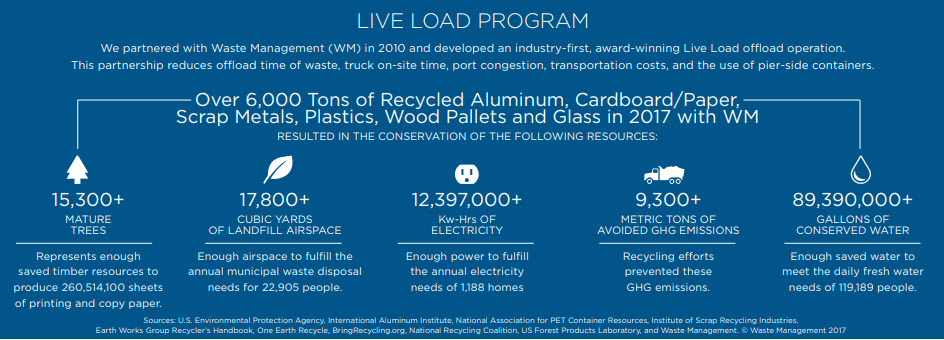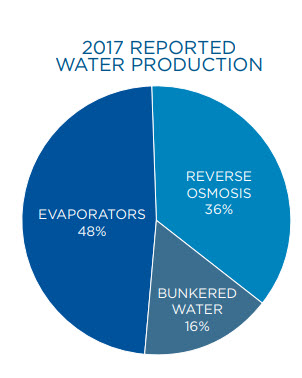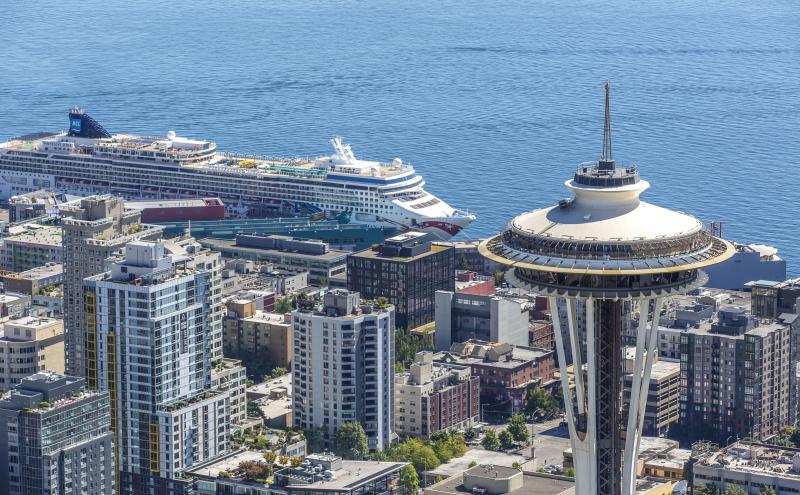
Beginning with the arrival of the Norwegian Bliss on May 30, Seattleites will soon get used to spotting a new type of marine life — the humpback whales painted on the ship’s hull by the artist Wyland. Not only are humpback whales an iconic element of the Alaska scenery, they’re also a reminder of Norwegian Cruise Line's (NCL) commitment to preserving the conditions of the oceans. The Port of Seattle is particularly interested in sustainability, so we looked into NCL's Sail & Sustain global environmental program.
In April 2018, Norwegian Cruise Line Holdings (the parent company of Norwegian Cruise Line, Oceania Cruises and Regent Seven Seas Cruises brands) released its 2017 Stewardship Report that highlights the company’s progress in minimizing waste to landfill, investing in emerging technologies, and reducing CO2 emissions. The cruise line has also established environmental partnerships with the Guy Harvey Ocean Foundation, the Alaska Raptor Center, and Nova Southeastern University’s Oceanographic Center in coral reef restoration.
According to the report, Norwegian Cruise Line Holdings is committed to:
- Increasing sustainable sourcing
- Minimizing waste to landfills
- Investing in emerging technologies
- Reducing their CO2 emissions
The company’s environmental stewardship includes initiatives in waste management, water conservation, and fuel and energy efficiency.
Waste Management and Mitigation
In 2010, Norwegian Cruise Line partnered with Waste Management to develop the Live Load offload operation to reduce offload time of waste, truck on-site time, port congestion, transportation costs, and the use of pier-side containers.
In 2017, Norwegian Cruise Line vessels who used the Live Load program recycled over 6,000 tons of recycled aluminum, cardboard/paper, scrap metals, plastics, wood pallets and glass. In more familiar terms, this resulted in:
- Diverting enough timber resources to produce 260,514,100 sheets of printing and copy paper
- Preserving enough landfill space to fulfill the annual municipal waste disposal needs for 22,905 people
- Saving enough power to fulfill the annual electricity needs of 1,188 homes
- Conserving enough water to meet the daily fresh water needs of 119,189 people

Other waste management initiatives include donating ship furnishings to the Salvation Army rather than disposing of them, and recycling metal from retired onboard equipment.
Water Conservation
Vessels within the Norwegian Cruise Line Holdings fleet produce the majority of the water used onboard and have reduced their overall water consumption by 2.7 percent, as compared to 2015.
- On average, 84 percent of the water used on ships is produced onboard through reverse osmosis and evaporators.
- 16 percent of the water used onboard is acquired in port
In 2017, the water sources on the company’s fleet came from the following sources:

Reverse Osmosis (RO) — Fresh and technical water produced onboard from seawater
- Between 2016 and 2017, Norwegian saw a 10 percent increase in production of reverse osmosis water.
- After installing a reverse osmosis plant in 2016, the Norwegian Sun saved 800 metric tons of boiler fuel
Evaporators — Fresh water produced from sea water using heat sources like the Exhaust Gas Boilers, Oil Fire Boilers, or Wasted Heat recovered from the main engine high-temperature cooling system.
Bunkered Water — Potable onboard water acquired in port.
Fuel and Energy Efficiency
The cruise line collects data from every ship to measure the biggest centers of power consumption. A few energy conservation highlights from 2017 include:
- Implementing Exhaust Gas Cleaning Systems (EGCS) technology, which scrubs the emissions to reduce sulfur oxide (SOx) and particulate matter emissions before they are released from the ship’s stack. This technology is used on eight ships and can reduce SOx emissions by up to 99 percent
- Switching lights in the onboard theaters of two ships to energy-efficient LEDs to save more than 93 megawatt hours of power savings per vessel
- Using a new low-friction paint system that increased propulsion efficiency by 4 percent (propulsion power represents just over 50 percent of the total energy use on a ship)
- Taking recovered heat from the ship’s engines to reduce boiler fuel consumption by 10 percent
For more information, read the 2017 Norwegian Cruise Lines Holdings Stewardship Report.








